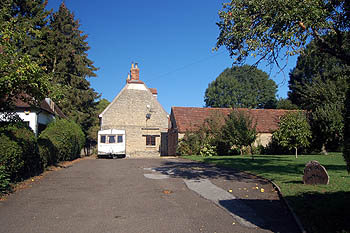
The gable end of 30 to 34 High Street September 2011
The Dukes of Bedford owned Oakley from 1737 to 1918 as Lords of the Manor of Oakley Reynes.Numbers 30 to 34 High Street were built by the estate in the 18th century.
The Bedfordshire Historic Environment Record [HER] contains information on the county’s historic buildings and landscapes and summaries of each entry can now be found online as part of the Heritage Gateway website. The three cottages [HER 1719] are described as being constructed from whitewashed rubble with old tiled roofs. They comprise two storeys. They were listed by the former Department of Environment in 1960 as Grade III, of local interest. Grade III status has since been abolished and so the properties are no longer listed.
The Oakley Estate was put up for sale by auction by the Duke of Bedford on 31st October 1918. The sale particulars [AD1147/18] list 30 to 34 High Street as Lot 22 and describe them as follows.
A Block of Three Cottages
stone, plaster and tiled
One containing Five Rooms, and the others Four Rooms each. OUTBUILDINGS: - Shed and earth Closet to each, and washhouse in common, together with Gardens
Situated in OakleyVillage, and being Part [Ordnance Survey Map Field] Number 44 and Part 57 on the Plan, and covering about
0 acres 1 rood 20 poles
(.375 Acre)
One is held by Mr. William Pales on Quarterly tenancy, and two are Void.
The Rating and Valuation Act 1925 specified that every building and piece of land in the country was to be assessed to determine its rateable value. Oakley, like most of the rest of the county, was assessed in 1927 and the valuer visiting 30 to 34 High Street [DV1/C99-101] found them owned by A. and E. Pales who had bought them in 1922.
Number 30 was occupied by F. C. Pales, Number 32 by A. Pales and Number 34 by William Pales. The rent when owned by the Oakley Estate in 1918 had been four shillings per week for each property. Accommodation comprised a kitchen and a living room downstairs with two bedrooms above, although Number 30 had an extra bedroom on the first floor. A wood and tiled barn and earth closet stood outside and water came from a well. The valuer commented: “Poor old places … but better than the old thatch”. They were then known as 9 to 11 The Village with 34 being 9 and 30 being 11.